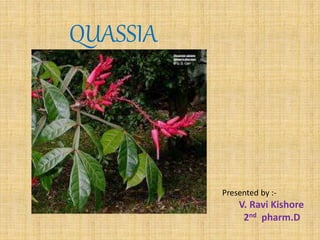Quassia
- 1. QUASSIA Presented by :- V. Ravi Kishore 2nd pharm.D
- 2. Synonym :- • Bitter wood , bitter ash , lignum quassiae, jamaica wood . Biological source:- • It is consist of dried wood of the stem of Quassia amara belongs to family : - Sumarubaceae.
- 3. Geographical source :- • Quassia amara .Linn is a native of Brazil and Guiana and is cultivated in Colombia , Panama and in West Indies and Caribbean Islands.
- 4. Cultivation and Collection :- It is normally grown from seeds ubiquitously in its native areas where it grows in pine ,ever green and deciduous Forest areas , and along roads and in villages. Seeds and cuttings can be used for propagation of Q.amara. Frost ( cool temp) is not tolerated, but the plant is partially drought tolerant. In India it is cultivated during rainy phase of summer season (kharif) crop. A large amount of indirect light is recommended. Any soil having fair amount of organic matter is suitable for commercial cultivation of this crop. About 400 gm seed are sufficient for 1 hectare the spacing is maintained 30*15 cm . No major insect and disease infestation has been reported.
- 5. the plant at flowering stages (90-120 days after sowing) are cut at the base leaving 10-15 cm stem for plant regeneration after 50-60 days after first harvest, final harvest is performed. Bark is removed from the stem and big branches are cut into logs of up to 30cm length or chips and dried to check moulds growth. In Indian condition , the yield varies between 2000-2500 kg dry herb/ hectare.
- 6. Macroscopy :- • Shape:- rasping , shaving or chips are plano- convex or concave-convex . Organoleptic character:- • Colour :- pale yellow to bright yellow • Odour :- odourless • Taste :- Intensely bitter
- 7. Extra features:- • Wood is straight grained , diffused and porous , sometimes black marking due to presence of mould , dark grey cork may be present. Microscopy :- • Xylem fibres ,thick walled , pitted , arranged in radial rows • Xylem parenchyma : small , polygonal , less thickened , pitted walls , few cells contain calcium oxalate crystals.
- 8. • Vessels : big , either single or in groups of few. • medullary rays : prominent , uniseriate , radially elongated pitted , contain few starch grains and calcium oxalate prisms,medullary rays are 6 to 10 to 15 to36 cells high and 1-4 cells wide.
- 11. CHEMICAL CONSTITUENTS: • Quassia and Neoquassian is a bitter terpenoid principles of Surinam Quassia while picrasmin(isoquassia) is the active constituent of Jamaica Quassia. • These bitter principles are obtained in 2% yields and appear commercially under the name of QUASSIN. • Other compounds reported from Quassia are 18-hydroxyquassin, scopoletin (coumarin)and cathine-6-one(alkaloid)
- 12. QUASSIN Other identified components of bitterwood are: beta- carbolines, beta-sitostenone, beta-sitosterol, dehydroquassins, gallic acid, gentisic acid, hydroxyquassins, isoparain, isoparaines, isoquassins, malic acid, methylcanthins, methoxycanthins, methoxycantins, nigakilactone A, nor-neoquassin, parain, paraines, quassialactol, quassimarin, quassinol, quassol and simalikalactone NEOQUASSIN
- 13. USES : Bitter tonic Insecticide. A good protection was shown against different insect pests e.g. aphids, Colorado potato beetle, Anthonomus pomorum , Rhagoletis cerasi, Caterpillars of Tortricidae. Anthelmintic Used to treatmeasles , diarrhea , fever, and lice. It also have Antifungal, Antitumor, Antifertility, Antileukemic, and Insecticidal activity.
- 14. Formulation:- Around 200 grams of Quassia wood chips are put together with 2 liters of water. It is allowed to stand for 24 hours and then it is cooked for 30 min. It is then diluted with 10 to 20 liters of water and used as a spray. The use of approximately 3-4.5 kg wood extract per hectare seems to be optimal to minimize the damage of Hoplocampa testudinea on apple trees.
- 15. Medicine :- Traditionally, Q. amara is used as a digestive, to treat fever, and against hair parasites (lice, fleas) and Mosquito larvae in ponds (and do not harm the fishes. The component Simalikalactone D was identified as an antimalarial. The preparation of a tea out of young leaves is used traditionally in French Guyana. Experiments showed a high inhibition of Plasmodium yoelii yoelii and Plasmodium falciparum. Other uses :- Extracts of Q. amara wood or bark are also used to flavor soft drinks, aperitifs and bitters which can be added to cocktails or to baked goods.
- 16. Contra indication :- In pregnancy and lactation.
















